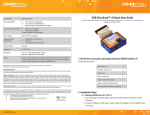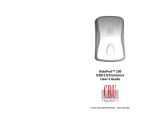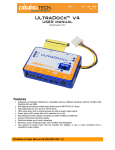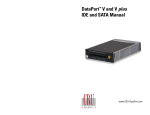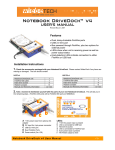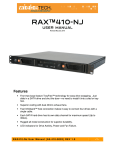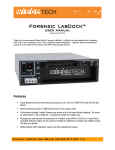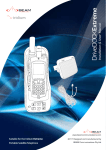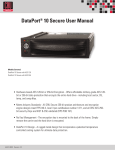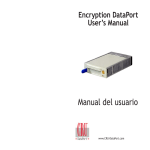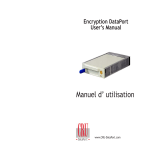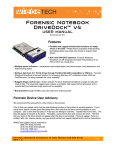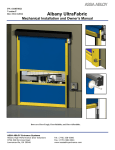Download Wiebetech USB DriveDock v5
Transcript
USB DriveDock™ v5 User Manual Revised January 20, 2012 Features • Fast USB 3.0 host interface • Connects to the four most common types of hard drive (2.5” & 3.5” SATA or PATA) • Two options for power input: Use the included AC adapter, or use a 4-wire power connector from a computer’s power supply • Power status LED verifies that unit is switched on (or off) • Small size allows you to take it anywhere 1. Pre-Installation 1.1 Check the accessories packaged with your USB DriveDock. The box should contain: USB DriveDock v5 AC adapter & power cord USB 3.0 cable eSATA to SATA cable Legacy to mini-fit adapter cable Legacy to SATA power adapter cable Quick Start Guide and warranty information 1 1 1 1 1 1 1 USB DriveDock User’s Guide (A9-000-0032 rev 1.0) -1- CRU-WiebeTech 1.2 Take a moment to familiarize yourself with the parts of your USB DriveDock. 1 2 3 C D E F G Drive Access LED USB connectivity LED Power LED A USB 3.0 port B Power input socket (from AC adapter) Power switch (“0” = OFF, “I” = ON) IDE ribbon cable, connects to 3.5″ IDE drive SATA drive connection Drive power connection 2.5″ IDE drive connection 2. Setup 2.1 Attaching SATA Drives (3.5” & 2.5”) a) Insert the legacy to mini-fit adapter cable into the Drive Power connection on USB DriveDock. b) Connect the legacy to SATA power adapter cable to the legacy to mini-fit adapter cable from step a). c) Attach the other end of the legacy to SATA power adapter cable into the SATA connection on the drive. d) Plug the eSATA to SATA cable into the SATA drive connection on USB DriveDock and into the eSATA connection on the drive. 2.2 Attaching IDE/PATA Drives (3.5” & 2.5”) a) Configure the jumpers on your hard drive. The drive must be set to the Master setting. Consult the instructions for your drive (some drives display configuration information on the drive’s label). A few drives have both “Master with Slave Present” and “Master without Slave” options. Choose the latter in this case. In rare cases, if the Master setting does not work then try Cable Select. Rear of hard drive IDE interface Jumper Pins Power USB DriveDock User’s Guide (A9-000-0032 rev 1.0) -2- CRU-WiebeTech b) With 3.5” drives, attach the free end of the IDE ribbon cable to the back of the hard drive. The connector is keyed to insert only one way. The IDE pins on the hard drive are fragile, so be very careful when inserting or removing the IDE connector With 2.5” drives, lift up the IDE ribbon cable, and attach the drive to the connecter underneath. c) Attach the legacy to mini-fit adapter cable from the dock into the back of the hard drive. As with the IDE cable, the connector will only fit one way. 2.3 Connecting and Powering USB DriveDock a) Connect the USB 3.0 cable from your computer into the corresponding port on the USB DriveDock. b) Connect power to the USB DriveDock. Use either the included AC adapter or, optionally, you can connect a 4-wire power cable from inside a computer case. This is useful if you wish to access a drive inside a computer without removing it first. USB DriveDock can use bus power for 2.5” and SSD drives. However, some hard drives have different power requirements especially when spinning up. The USB port can only provide so much power and when it exceeds this amount you may get an error message on the computer. If this occurs we suggest that you use the included AC adapter to power your dock and the attached drive. Your USB DriveDock is now ready to use! Turn on the unit by moving the power switch to the “I” position. The green drive access indicator will light briefly after the unit is powered up, indicating that USB DriveDock has successfully established communication with the drive. Thereafter, it will light whenever the drive is accessed. 2.4 Using USB DriveDock with Combo Adapters CRU-WiebeTech offers optional Combo Adapters that can allow your USB DriveDock to access many additional types of drives. Follow these three simple steps to use a Combo Adapter with your dock: a) Attach USB DriveDock’s 4-wire power connector to the adapter. b) Connect USB DriveDock’s drive cable to the corresponding connector on the adapter. c) Connect the drive to the adapter. You are now ready to use USB DriveDock to access the drive. Combo Adapters are available for SATA drives, notebook drives, MicroDrives, ZIF drives, and more. See the WiebeTech website for more details (www.wiebetech.com). USB DriveDock User’s Guide (A9-000-0032 rev 1.0) -3- CRU-WiebeTech 3. Usage with Mac and Windows Operating Systems 3.1 Usage with Mac OS X 3.1.1 Compatibility USB DriveDock does not require drivers for operation under Mac OS X. However, if you install a host card specifically to work with this product, that card may require drivers. See your card’s User Manual for drivers and instructions. 3.1.2 Using Volumes The hard drive attached to the USB DriveDock will appear as an icon representing the drive’s volume on the desktop. You can begin using the volume right away. If the drive is unformatted, a message will appear on the desktop saying that the disk is unreadable. Eject the volume before powering down the unit by dragging the volume’s icon to the trash bin, or by selecting the volume then pressing Command-E. Shutting down the unit without first ejecting the volume can result in data loss. 3.1.3 Booting from your USB DriveDock Some Macs support booting from an external device. To activate this feature, you must first install OS X on the external volume. The easiest way to do this is to clone an existing system drive using a utility such as Carbon Copy Cloner or Super Duper. Next, go to System Preferences Æ Startup Disk. A window will list the available bootable volumes. Select the volume from which you wish to boot. Another method is to hold down the Option key during boot up. A screen should appear that allows you to select the volume you wish to use. This is useful if you wish to boot from your dock only some of the time. 3.2 Usage with Windows operating systems 3.2.1 Compatibility USB DriveDock does not require drivers for operation under Windows XP, Vista, or 7. However, if you install a host card specifically to work with this product, that card may require drivers. See your card’s User Manual for drivers and instructions. 3.2.2 Using Volumes When the dock and drive are properly connected and turned on, a window may open to allow you access to the volume. If no window appears, you can find the volume by double-clicking the “My Computer” icon. Eject the volume before powering down the unit by single-clicking the green arrow icon on the task bar, then selecting “Safely remove….” Windows will indicate when it is safe to disconnect the dock. Shutting down the unit without first ejecting the volume can result in data loss. (Windows XP) 3.2.3 Booting from USB DriveDock Some PC motherboards support booting from an external device. To activate this feature, you will need to adjust the motherboard’s BIOS settings. Check with your motherboard’s manufacturer or owner’s manual for details. USB DriveDock User’s Guide (A9-000-0032 rev 1.0) -4- CRU-WiebeTech 4. Frequently Asked Questions Q: My USB DriveDock works great with SATA drives but I am having compatibility issues with IDE/PATA drives. What should I do? A: First check to make sure the SATA power/data cable is unplugged from the SATA drive connector on the dock. IDE/PATA drives cannot be recognized if a SATA cable is plugged in. Next check to make sure the 4-pin power cable is plugged into the IDE/PATA drive. If the power and host connection are securely attached to the Forensic UltraDock, then the IDE cable may be faulty. Contact Technical Support for further instructions. Q: Why does my dock experience errors or unmount during long file transfers? A: The environment in which the dock is used can affect its performance. The surface that the dock and drive are set upon may not allow heat to dissipate away from the units. The bottom plate supplied with the product will help to dissipate heat away from the hard drive and dock. If placed on a non-conductive surface, the drive or dock may suffer heat related failures. After cooling, the units usually return to a useable state. Occasionally these heat-related failures can be permanent. Q: I am trying to bus power my drive and my computer is telling me that the USB device is drawing too much power. How can I fix this? A: Some hard drives have different power requirements especially when spinning up. The USB port can only provide so much power and when it exceeds this amount you will get a similar error to the above message. When this occurs we suggest that you use the included AC adapter to power your USBDDv5 and the drive attached. USB DriveDock User’s Guide (A9-000-0032 rev 1.0) -5- CRU-WiebeTech 5. Technical Specifications Product Name Host Interfaces and speeds* Drive Interfaces USB DriveDock v5 USB 2.0: Up to 480 Mbps USB 3.0: Up to 5.0 Gbps *Actual throughput is drive dependant. • 2.5” IDE/PATA interface • 3.5” IDE/PATA interface • SATA interface (for both 2.5” & 3.5” drives) Power Adapter (included) +5V/+12V 2A/2A AC adapter Compatibility 2.5” & 3.5” SATA and IDE/PATA hard disk drives Operating System Requirements • Windows XP, Vista, Windows 7 • Mac OS X • Linux distributions supporting USB Compliance CE, FCC, RoHs Shipping Weight 2 pounds Dimensions Support 3.2” x 2.2” x 0.95” (81mm x 56mm x 24mm) Dimensions are exclusive of attached plates, drives, and cables. We don’t want anything to go wrong with your CRU-DataPort product. But if it does, Tech Support is standing by and ready to help. Contact us through crudataport.com. CRU also offers phone support at (800-260-9800). WiebeTech is a brand of CRU. © 2008, 2011 CRU Acquisitions Group, LLC. All rights reserved. DriveDock and WiebeTech are trademarks of CRU Acquisitions Group, LLC. Other marks are the property of their respective owners. Limited Product Warranty CRU-DataPort (CRU) warrants this product to be free of significant defects in material and workmanship for a period of one year from the original date of purchase. CRU’s warranty is nontransferable and is limited to the original purchaser. Limitation of Liability The warranties set forth in this agreement replace all other warranties. CRU expressly disclaims all other warranties, including but not limited to, the implied warranties of merchantability and fitness for a particular purpose and non-infringement of third-party rights with respect to the documentation and hardware. No CRU dealer, agent or employee is authorized to make any modification, extension, or addition to this warranty. In no event will CRU or its suppliers be liable for any costs of procurement of substitute products or services, lost profits, loss of information or data, computer malfunction, or any other special, indirect, consequential, or incidental damages arising in any way out of the sale of, use of, or inability to use any CRU product or service, even if CRU has been advised of the possibility of such damages. In no case shall CRU’s liability exceed the actual money paid for the products at issue. CRU reserves the right to make modifications and additions to this product without notice or taking on additional liability. FCC Compliance Statement: “This device complies with Part 15 of the FCC rules. Operation is subject to the following two conditions: (1) This device may not cause harmful interference, and (2) this device must accept any interference received, including interference that may cause undesired operation.” This equipment has been tested and found to comply with the limits for a Class A digital device, pursuant to Part 15 of the FCC Rules. These limits are designed to provide reasonable protection against harmful interference when the equipment is operated in a home or commercial environment. This equipment generates, uses, and can radiate radio frequency energy and, if not installed and used in accordance with the instruction manual, may cause harmful interference to radio communications. In the event that you experience Radio Frequency Interference, you should take the following steps to resolve the problem: 1) Ensure that the case of your attached drive is grounded. 2) Use a data cable with RFI reducing ferrites on each end. 3) Use a power supply with an RFI reducing ferrite approximately Tested to comply 5 inches from the DC plug. with FCC standards 4) Reorient or relocate the receiving antenna. FOR OFFICE OR COMMERCIAL USE USB DriveDock User’s Guide (A9-000-0032 rev 1.0) -6-






